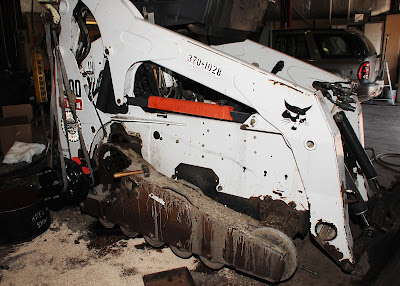There are many unsung heroes that work along the side of the roads and behind
the scenes to help maintain the highways. In today’s Work Zone Wednesday, we
will look at a few ways KDOT maintenance crews work to keep Kansas moving.
Mowing
Troy Whitworth, KDOT’s Assistant to the Director of Operations, said one of the ways KDOT maintains the highways is by mowing any excessively tall grass and weedy areas around intersections, curve ramps and entrances. Mowing these areas helps to improve sight distance. He said KDOT crews usually operate medium duty farm type tractors with brush hog mowers that have 10 feet or 15 feet mower decks.
Troy Whitworth, KDOT’s Assistant to the Director of Operations, said one of the ways KDOT maintains the highways is by mowing any excessively tall grass and weedy areas around intersections, curve ramps and entrances. Mowing these areas helps to improve sight distance. He said KDOT crews usually operate medium duty farm type tractors with brush hog mowers that have 10 feet or 15 feet mower decks.
 |
| Burke Richter, a KDOT Equipment Operatorr, mows grass along U.S 156 east of Garden City. |
Some grasses and plants that grow alongside Kansas highways are
visually appealing and serve as natural habitat for wildlife. Because of this,
KDOT has partnered with the Kansas Audubon Society to develop a mowing policy
that accomplishes roadside management that is both beautiful and functional along
our roadways.
 |
| David Shaw, a KDOT Equipment Operator, mows grass along the U.S. 50 bypass near Dodge City. |
Painting
 |
| KDOT maintenance truck lays down fresh painted lines along the highway. |
Whitworth said that painting lines on our highways provides traffic
guidance and are important to let drivers know where they are while driving on
the roadway.
“Painting pavement lines provides defined lanes for the
traveling public to drive in,” Whitworth said. “By using the painted lines, you
will know if you are driving on two-lane roadway with head-to-head traffic or a
multi-lane highway where the traffic is all traveling the same direction.
Without the pavement lines, you may not have a frame of reference for the
roadway at times of low light, night time or during inclement weather.”
KDOT’s paint is embedded with reflective glass beads that
cause light refraction, which makes the lines glow when headlights shine on
them at night. The longevity of the reflective lines can vary and sometimes
maintenance crews are dispatched to repaint the lines, especially after a bad
winter. Snow plows can damage the pavement markings by scraping off the
reflective beads while clearing the roadways.
Signing
 |
| KDOT Maintenance crews update a speed limit sign in this photo from 2011. |
Whitworth said that there are three types of signs along the
roadway: Regulatory, warning and guide signs. Regulatory signs alert drivers of
the laws and regulations that are enforceable. Warning signs guide the driver
when it comes to making important decisions on how to operate the vehicle.
Guide signs provide the driver with navigational information.
KDOT signs are typically made of aluminum metal sheets and are cut or stamped out of the shape that is required for a specific sign, such as an octagonal stop sign.
KDOT signs are typically made of aluminum metal sheets and are cut or stamped out of the shape that is required for a specific sign, such as an octagonal stop sign.
 |
| KDOT crews install signs along state highways. |
“The adhesive material that is applied to the aluminum shape
may have a reflective quality to it and is pressed into the aluminum shape,”
Whitworth said. “Typically, the sign shape has holes that are cut during the
stamping process, which allows workers to mount the sign.”
There are times when a sign may need to be repaired or
replaced.
“If the sign face is worn, faded or the reflective sheeting
is damaged, we may need to replace the sign if it no longer serves its
purpose,” Whitworth said.
KDOT maintenance workers face several challenges while
working along the highways.
“Traffic and traffic control are some of the challenges of
working on the roadway,” Whitworth said. “Traffic speeds and inattentive
drivers can really cause issues during any work that is being done on or near
the roadway. Our employees are also out in extreme conditions throughout the
various seasons.”
Remember to slow down in work zones and always be aware of
your surroundings. Never use your cell phone while driving and look out for
highway workers.



























